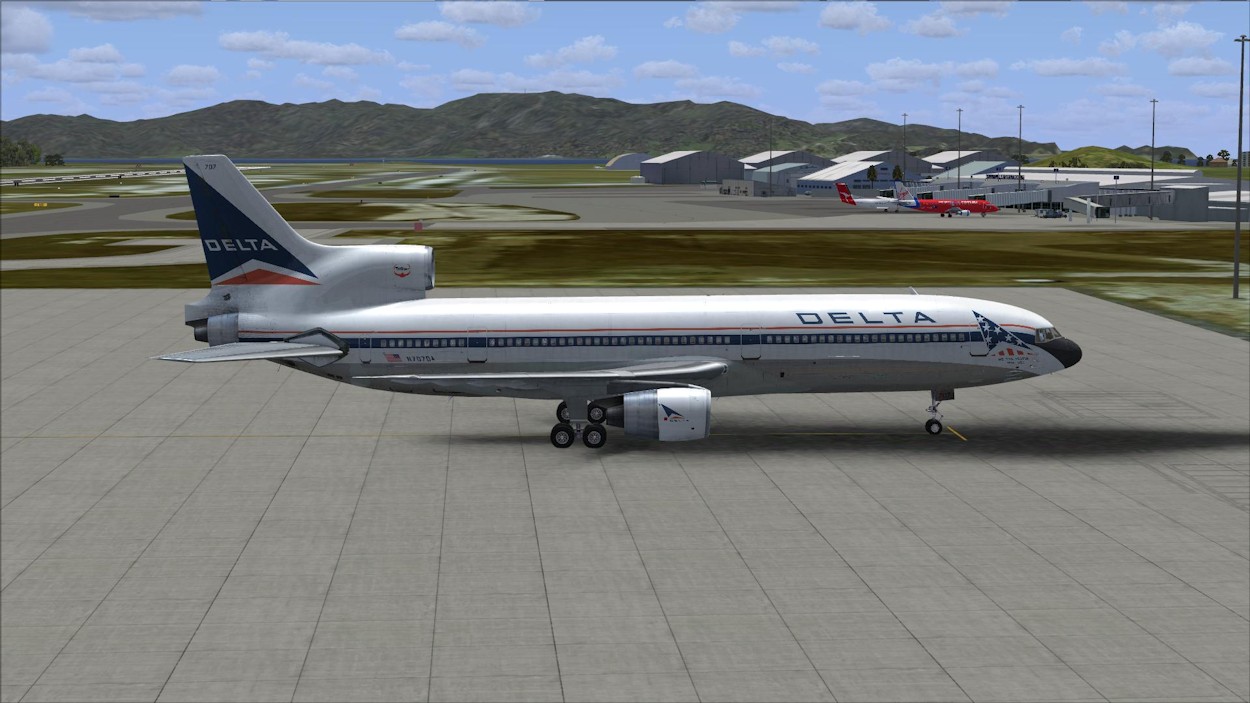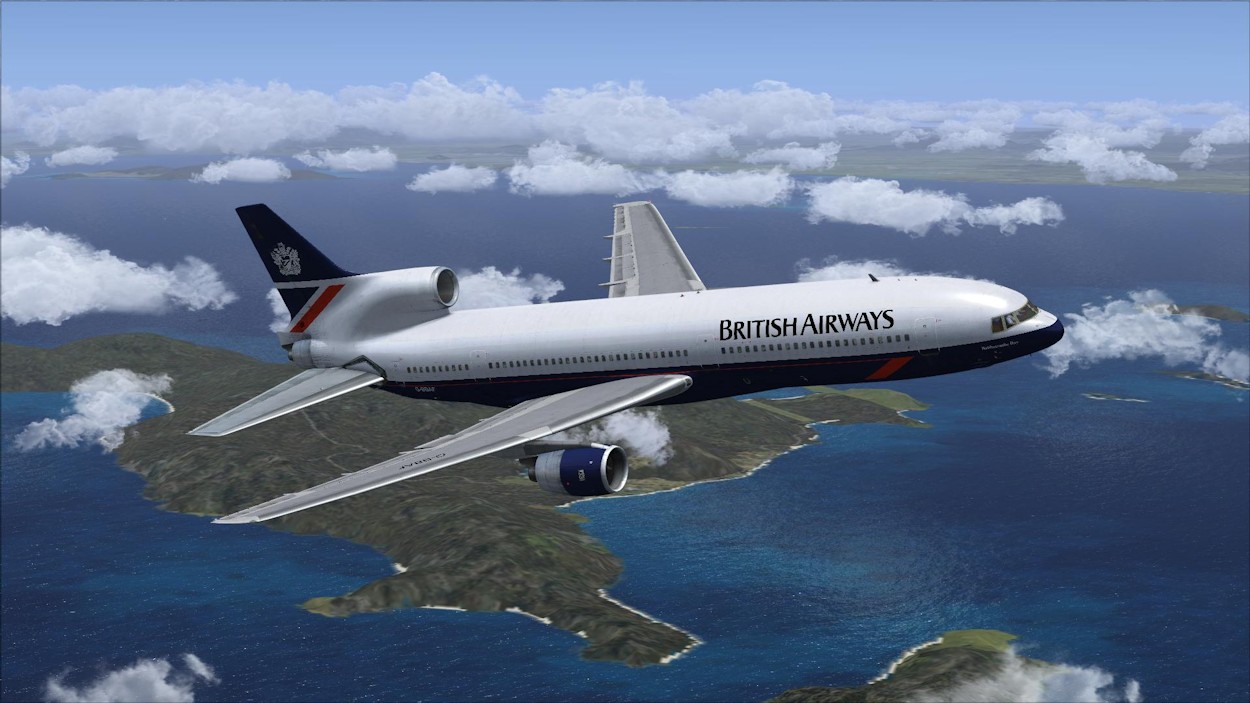Introduction
After the success of their early airliner designs, notably the
Lockheed 'Constellation' series, and the short lived L-188
'Electra', the Lockheed L-1011 'TriStar' was seen by Lockheed as
an opportunity to re-enter the commercial airliner market. A
wide body design, featuring an autopilot system certified for
CAT IIIc auto landings, the 'TriStar' was more efficient than
its competitor, the Douglas DC-10. However, major production and
financial problems with Rolls-Royce, the manufacturer of the
RB211 engines on the 'TriStar', resulted in major production
delays for the 'TriStar' and ultimately sealed its fate and
Lockheed's permanent departure from the commercial airliner
market
Captain Sim have been producing high quality, extremely
detailed, add-on aircraft for Microsoft Flight Simulator for
close on 15 years. Their earlier 'Legendary' series is well
renowned, but a lesser known fact is they produced the F/A-18
model for FSX Acceleration. In 2006, Captain Sim released the
first of the 'Pro Line' product range, the '757 Captain'. Under
the 'Captain' title range, Captain Sim have continued to develop
a range of modern airliners with an additional range of classic
airliners developed in the 'Nostalgy' series. The '1011 Captain'
is the latest development and displays the usual Captain Sim
traits, including the development of a freighter model.
History
The Lockheed L-1011 'TriStar' is a medium to long range, wide
body, trijet airliner. It has a seating capacity of up to 400
passengers and a range of over 4,000 nm (7,410 km). Commonly
referred to as the L-1011 (pronounced "L-ten-eleven") or
'TriStar', its trijet configuration of a Rolls-Royce RB211
engine under each wing, and a third, centre mounted RB211 engine
with an S-duct air inlet embedded in the tail and the upper
fuselage, is distinctive.
The L-1011 'TriStar' was produced in two fuselage lengths. The
original L-1011-1 first flew in November 1970 and entered
service in 1972. The shortened, long range L-1011-500 first flew
in 1978 and entered service in 1979. The L-1011-1 was also
produced in a high gross weight variant and subsequent
production variants provided further increases to take-off
weights. The aircraft's design incorporated some pioneering
technologies, including a highly advanced autopilot system,
providing an auto landing capability, and an automated descent
control system, the Direct Lift Control (DLC) system.
Consequently, it was the first wide body airliner to be
certified for CAT IIIc auto landings. The aircraft's design
features also included a lower deck galley and lounge
facilities.
The 'TriStar' was the third wide body airliner to enter
commercial operations after the Boeing 747 and the McDonnell
Douglas DC-10. When production ended in 1984, Lockheed had
manufactured a total of 250 'TriStars'. The aircraft's sales
were hampered by two years of delays due to developmental and
financial problems at Rolls-Royce, the sole manufacturer of the
'TriStar's' engines. After production ended and due to the
'TriStar's' below target sales, Lockheed withdrew from the
commercial aircraft business entirely.
The '1011 Captain' is currently available direct from Captain Sim as a 'download only' product. It is priced at €29.99, or the equivalent on currency cross rates. The download file size of 304MB is reasonable for an aircraft of this type and quality and it requires approximately 1.5GB of HDD space for installation. You will receive an email providing you with your order number and this is required during installation and any re-installation.
The '1011-F' Freighter Expansion Model is also currently available direct from Captain Sim as a 'download only' product. It is priced at €9.99, or the equivalent on currency cross rates. The download file size of 37.4MB is again reasonable for such a model expansion of this type and quality and it requires approximately 70MB of HDD space for installation. You will also receive an email providing you with your order number for this expansion model and this is required during installation and any re-installation. The '1011 Captain' product is required for the installation of the '1011-F' Freighter Expansion Model.
The installation process is simple and seamless and it also installs the Captain Sim Aircraft Configuration Editor (ACE).
Note. The '1011 Captain' version reviewed is the FSX version and IS NOT compatible with P3D. There is a P3D specific version available from Captain Sim. The '1011-F' Freighter Expansion Model is a single version and IS compatible with both the FSX and P3D versions of the '1011 Captain' product.
Model Features
The Lockheed L-1011 'TriStar' is a classic commercial airliner with a traditional analogue ('steam powered') avionics suite. The model features listed by Captain Sim for the '1011 Captain' and '1011-F' are extensive and typical of models in the Captain Sim range.
The following summary of the major features provides a limited overview of the extent of the detail included in these packages:
● General:
● highly detailed and accurate;
● 4x high resolution textures;
● realistic flight model;
● animation control panel;
● authentic sound set;
● repaint kit; and
● comprehensive documentation.
● Exterior:
● realistic animations:
● wing flex and wing vortices;
● landing gear and landing gear doors, with nose wheel steering;
● stabiliser, elevators, rudder, rudder trim, and inboard and outboard ailerons;
● wing slats and flaps;
● spoilers;
● engine reversers, cowlings, and intake covers;
● radome and radar antenna;
● passenger and service doors, and escape slides;
● emergency exit;
● aft and forward cargo doors; and
● service access doors.
● Interior:
● highly detailed and functional flight deck;
● detailed systems with extensive advanced system programming, including:
● weather radar;
● CIVA INS;
● fuel;
● electrical;
● hydraulics;
● power plant;
● pneumatics; and
● air conditioning and pressurisation.
● accurate animations; and
● custom lighting control.
● Freighter Expansion Model (in addition to the above listed features):
● realistic animations:
● main cargo door;
● main deck animated cargo loader; and
● animated cargo ULDs (containers).
● main deck load manager control panel;
● real time cargo load calculation; and
● real time aircraft weight and CG update according to the calculation.
The '1011 Captain' is provided with a single model, the initial production L-1011-1 variant. The '1011-F' Freighter Expansion Model adds the freighter variant, also based on the initial production L-1011-1 variant.
Aircraft Configuration Editor (ACE). The ACE is a configuration tool which streamlines the process for the easy installing or uninstalling of liveries. It also provides a weight and balance configuration tool which easily enables you to adjust the configuration of both passengers and cargo unit load devices (ULDs). When you have both products installed, the ACE differentiates between the passenger and freighter models for livery management. Weight and balance for the freighter model is affected in real time using the main deck load manager control panel within FSX.
|
ACE Livery Management |
ACE Weight & Balance Management |
General. Captain Sim have built a reputation on, and are renowned for the accuracy and detail of their models. All I can say is, they definitely do not disappoint with the '1011 Captain' and the '1011-F' Freighter Expansion Model.
Exterior. The Lockheed L-1011 'TriStar' has very distinctive lines. Whilst it displays the characteristic general wide body airliner appearance, the third, centred mounted engine embedded in the tail and upper fuselage gives the 'TriStar' its distinctive appearance. Captain Sim's modelling of the Lockheed L-1011 'TriStar' is excellent. Not only is the modelling very accurate, it is extremely detailed, with sharp, crisp lines. A comparative review of photographs of real world aircraft to Captain Sim's rendition reveal the exterior shape and dimensions to be extremely accurate and a true representation of the real world aircraft. There were some noted differences, but these are considered to be related to real world production variations or a degree of artistic licence on the part of the developer.
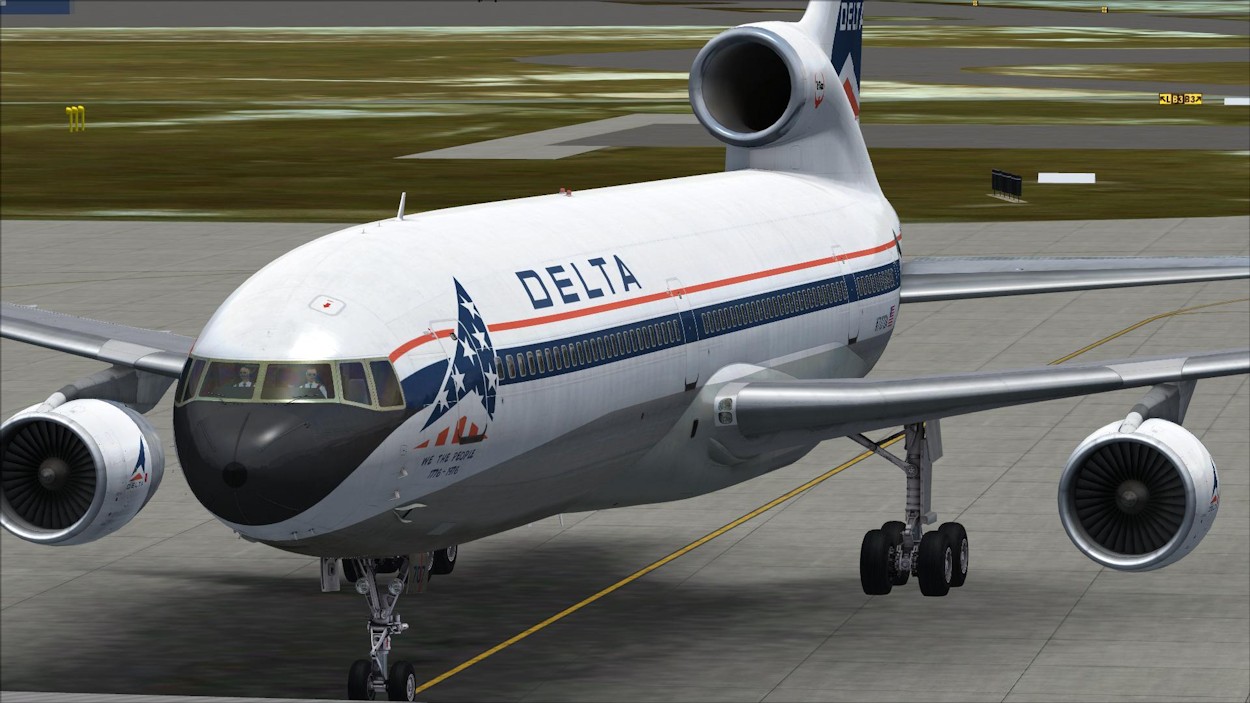 Nose Detail |
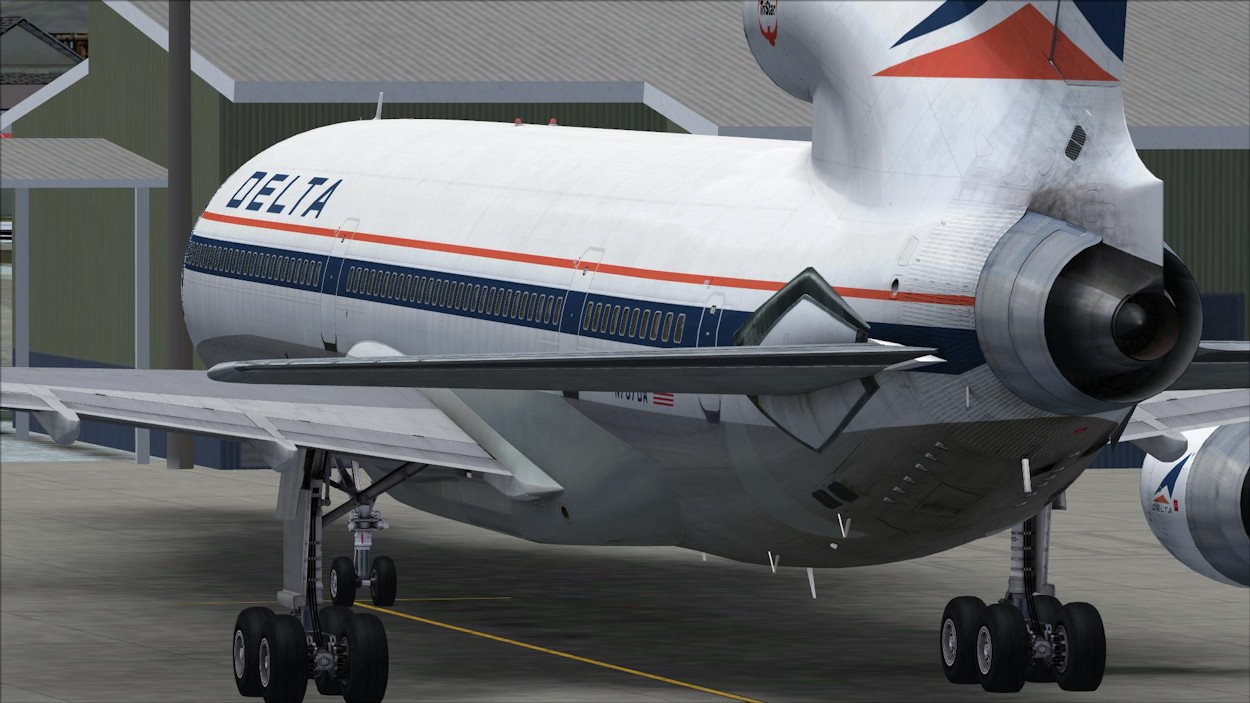 Tail Detail |
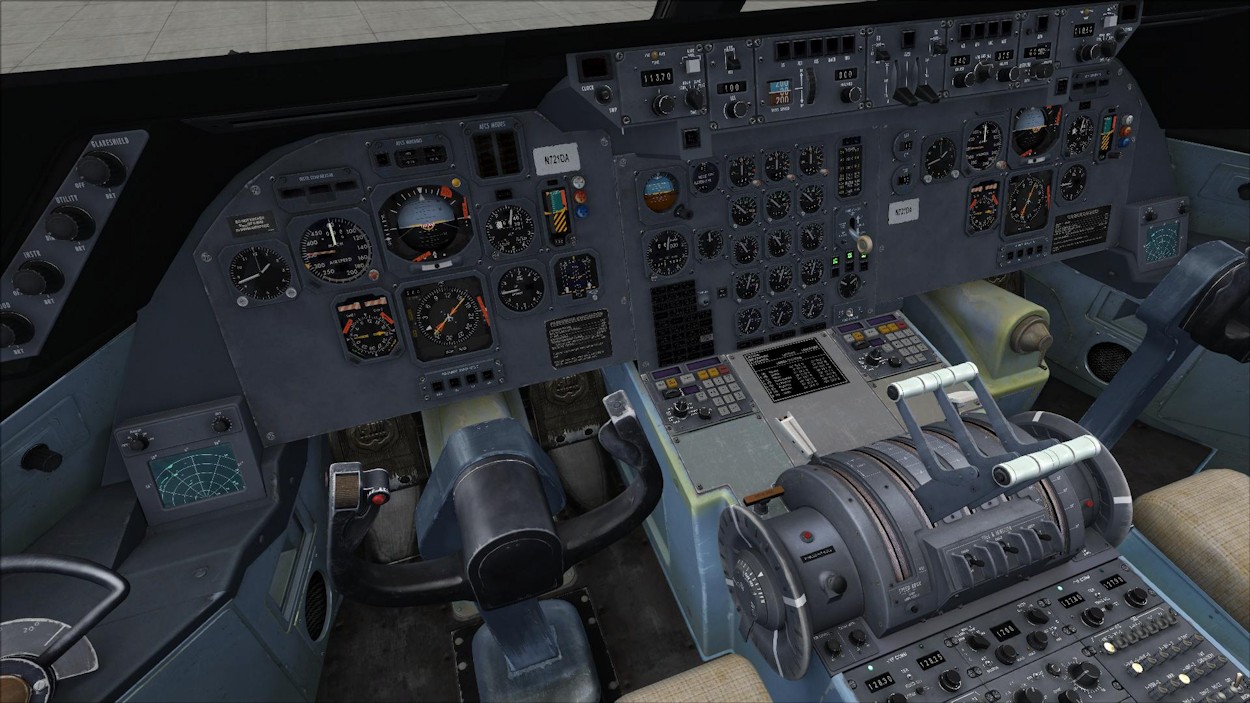 Captain's View |
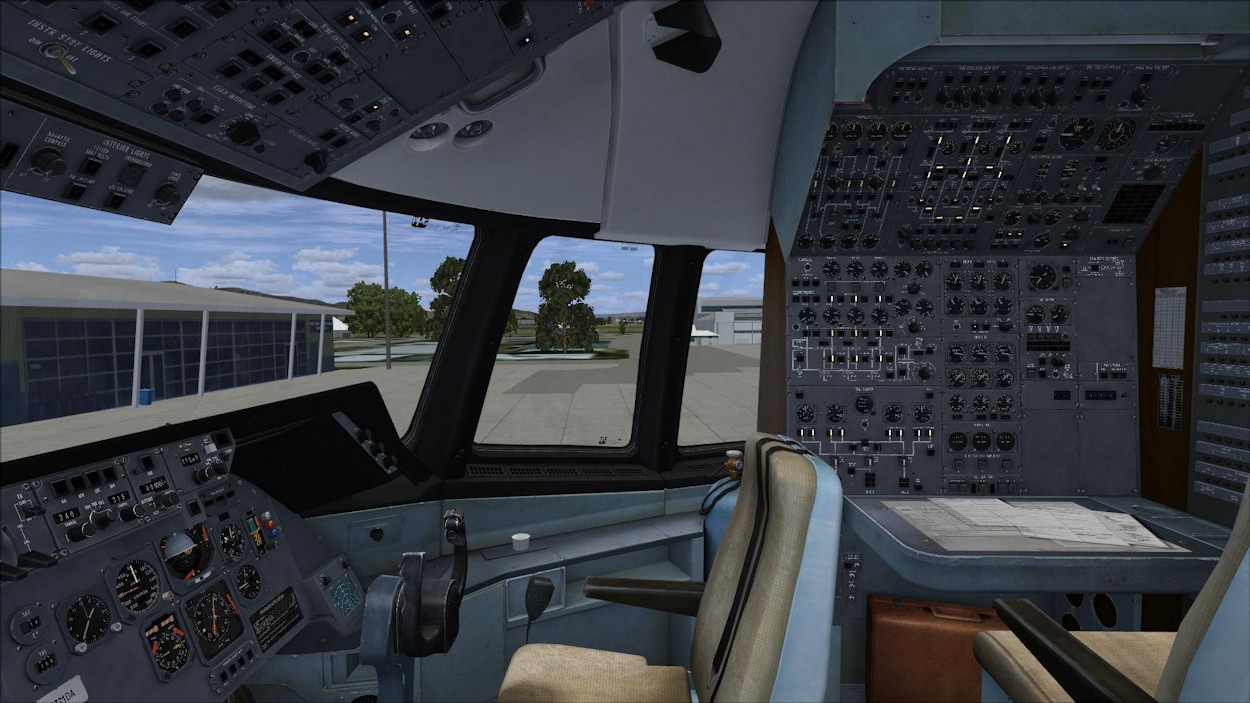 First Officer & Flight Engineer's Positions |
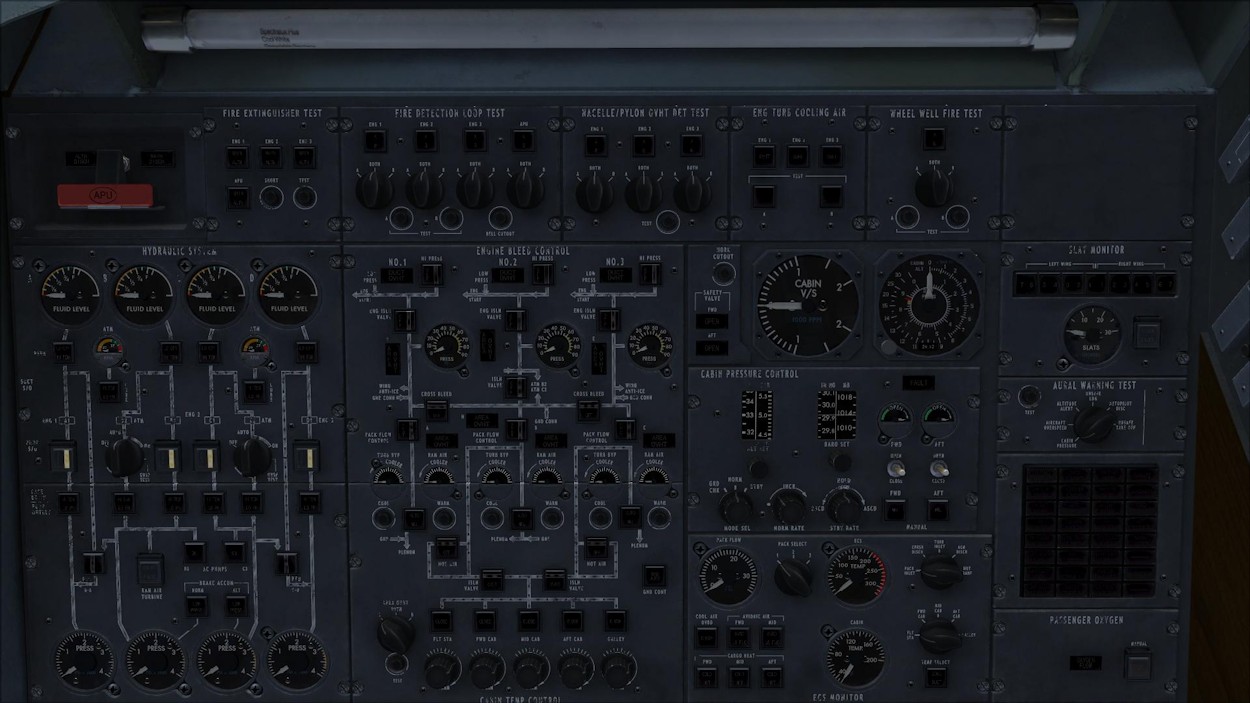 Flight Engineer Station Upper Panel |
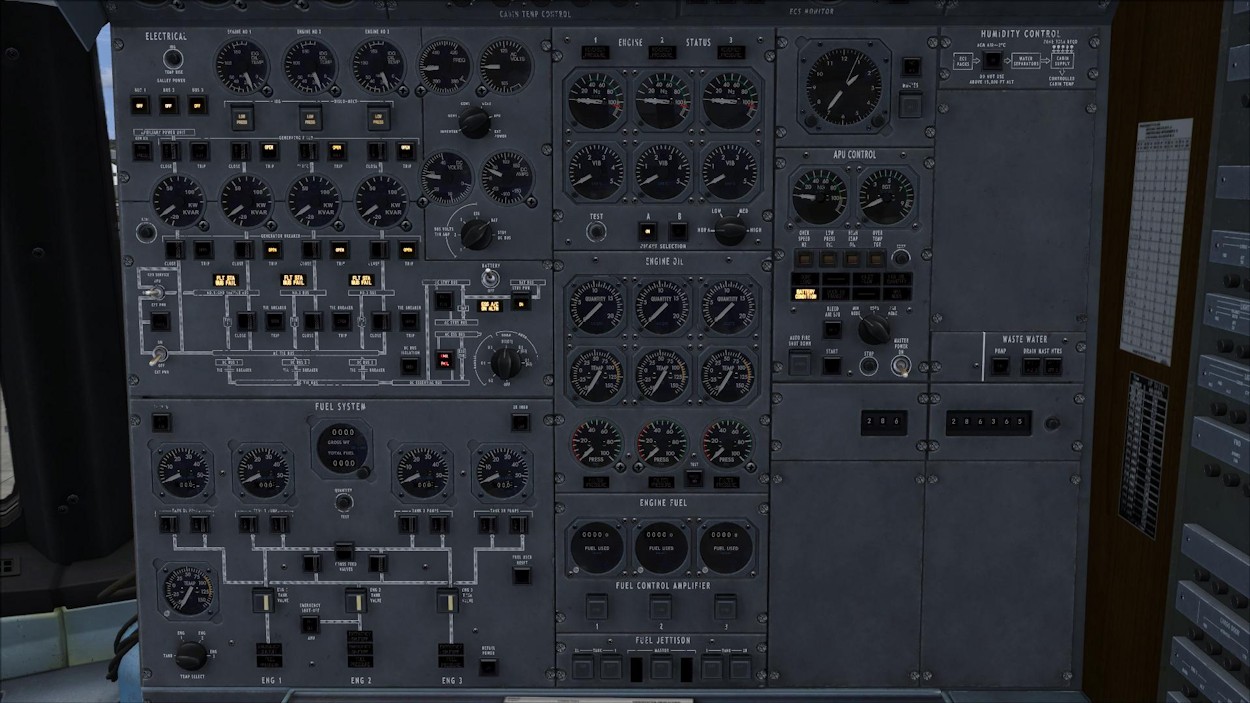 Flight Engineer Station Lower Panel |
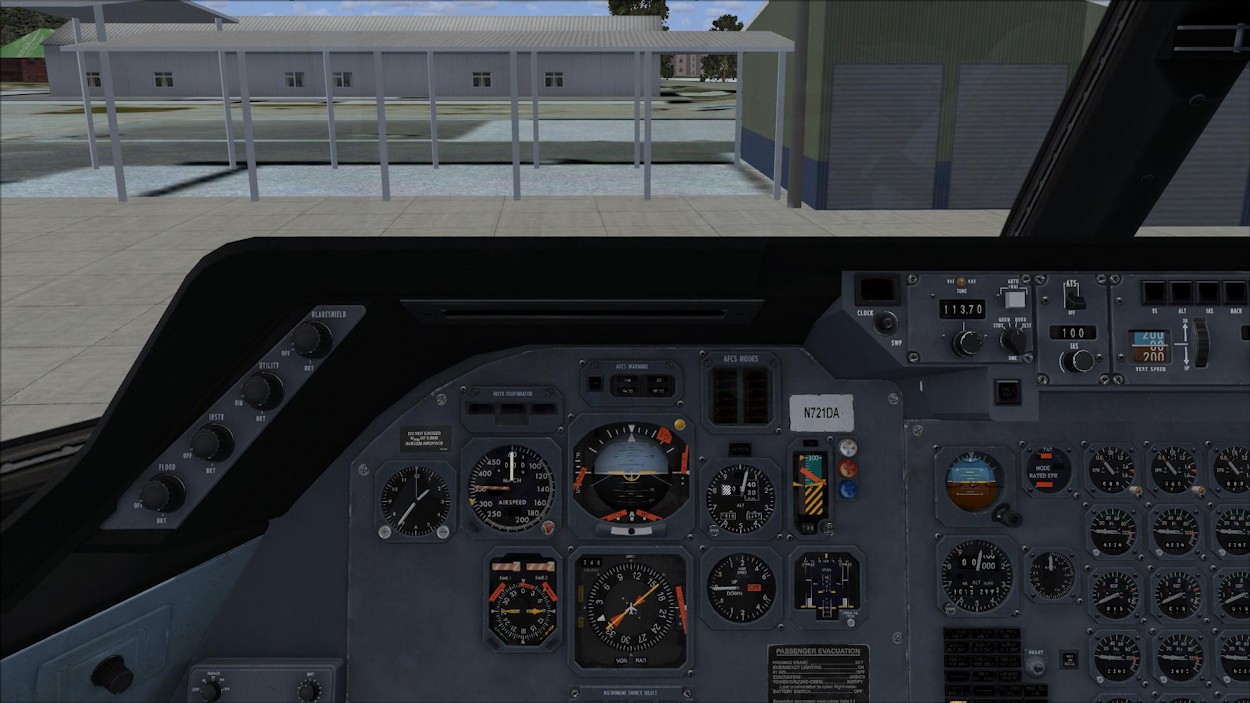 Captain's View |
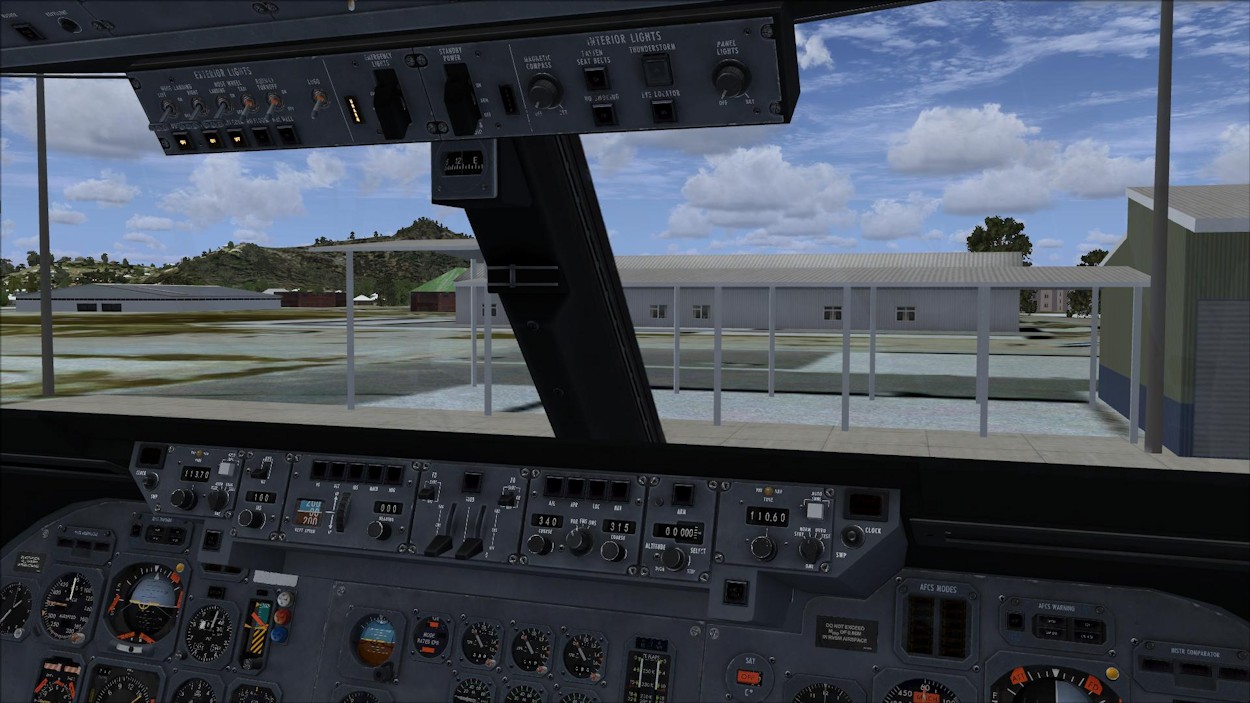 First Officer's View |
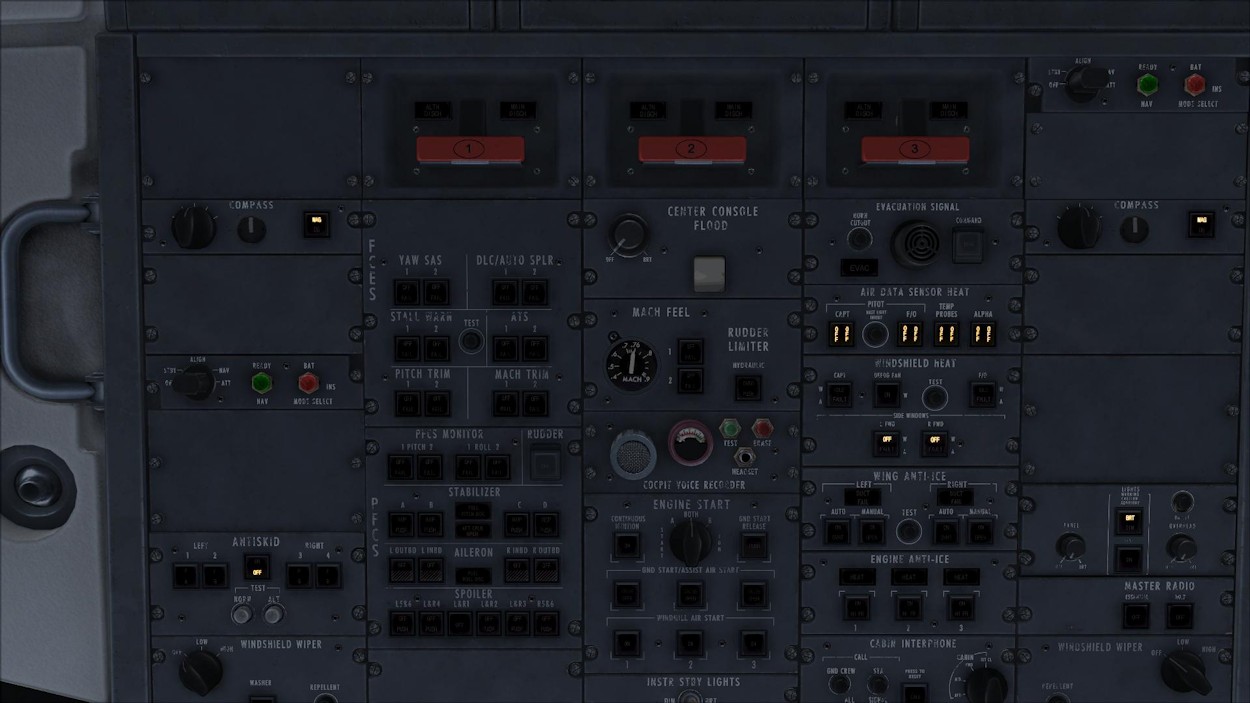 Overhead Panel |
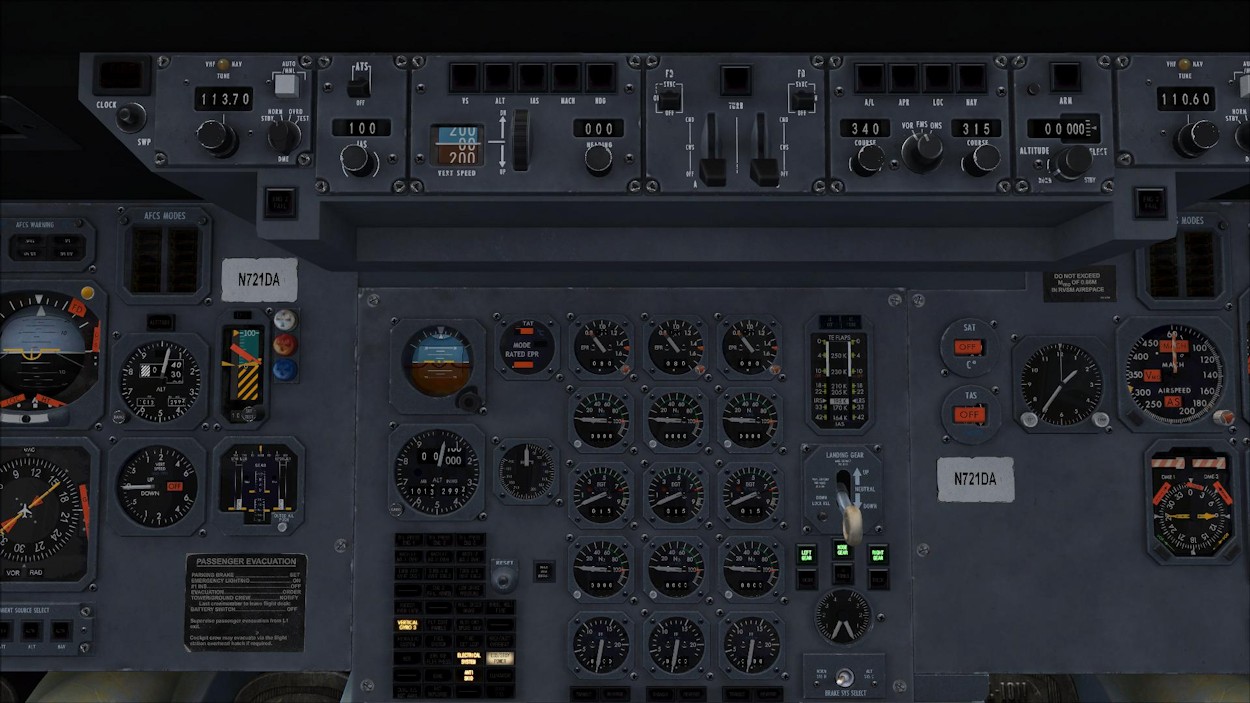 Autopilot & Engine Gauges |
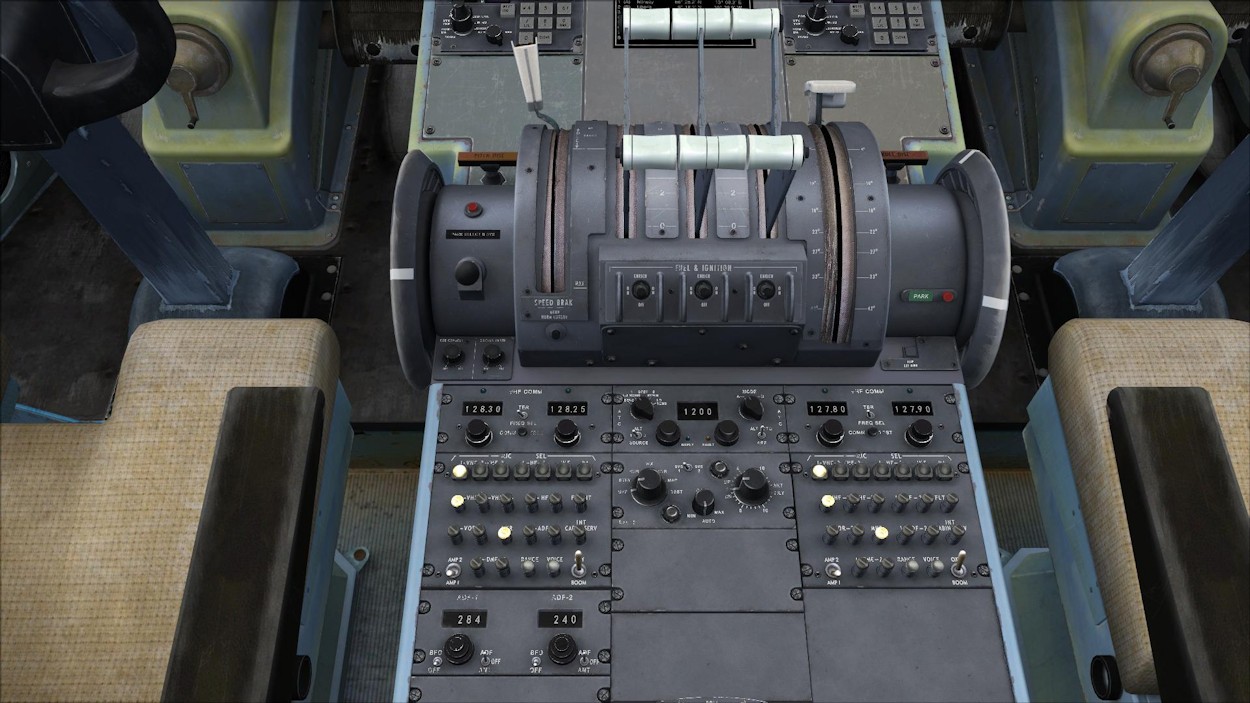 Pedestal Console |
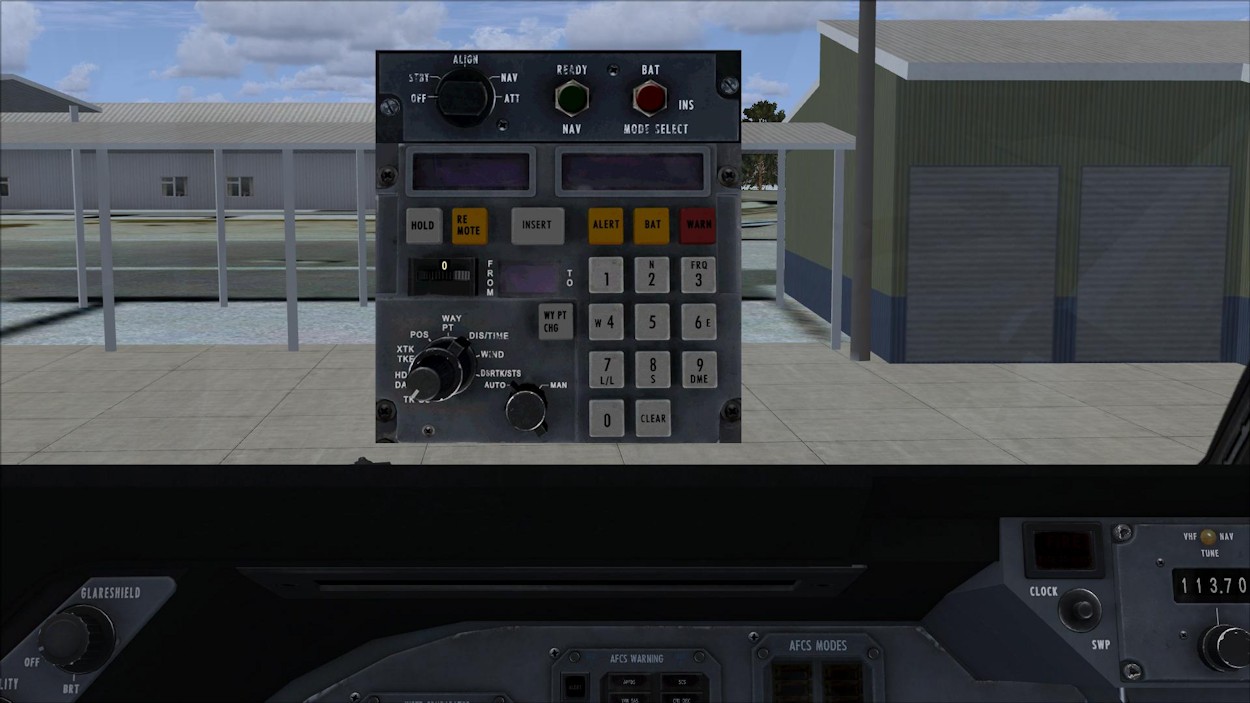 CIVA INS |
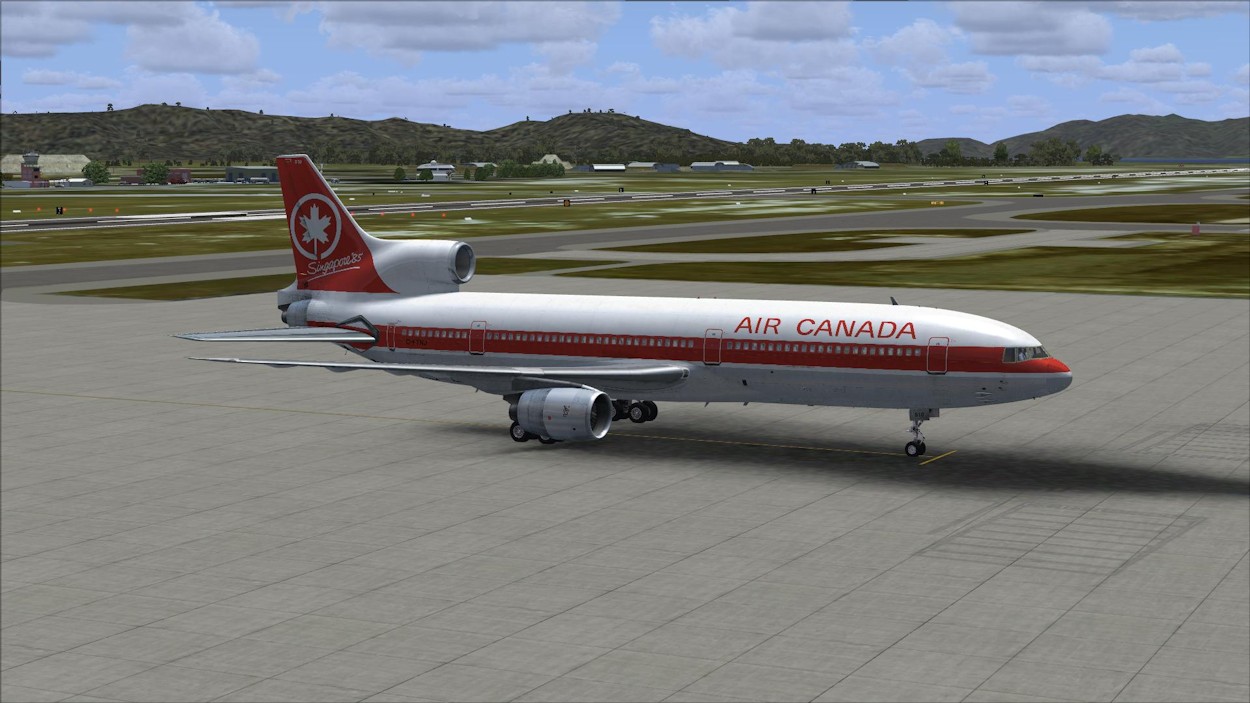 Air Canada |
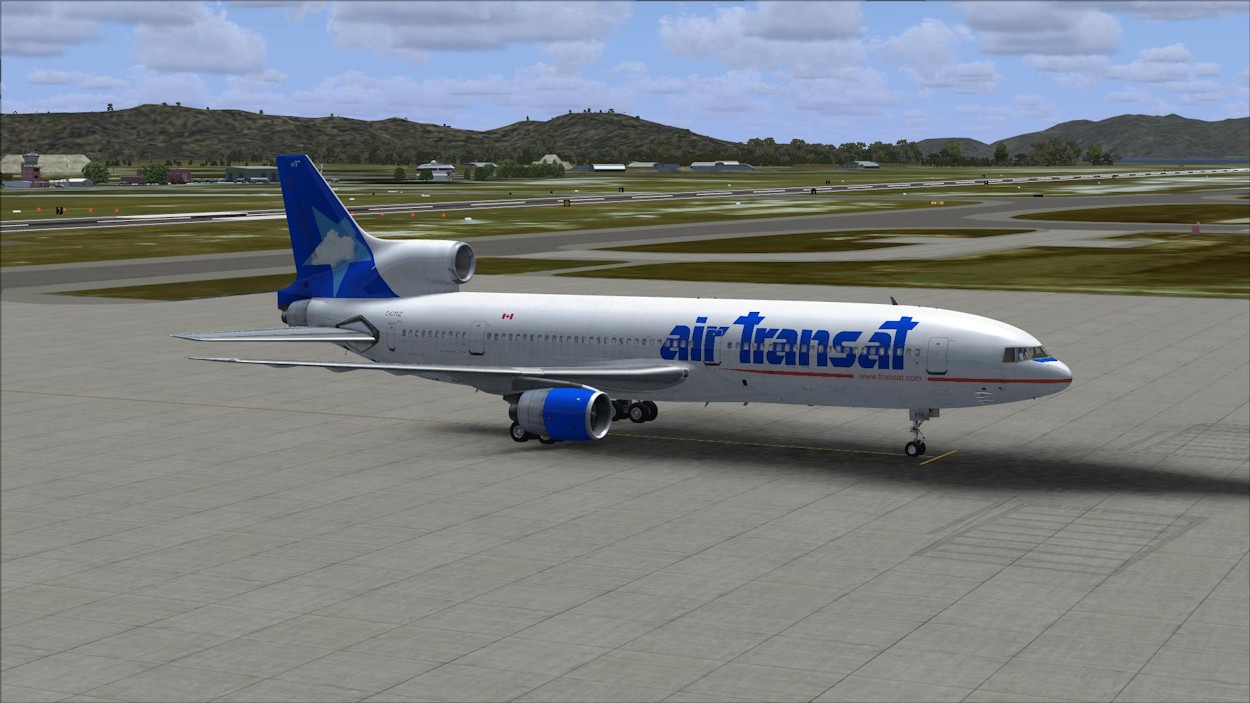 Air Transat |
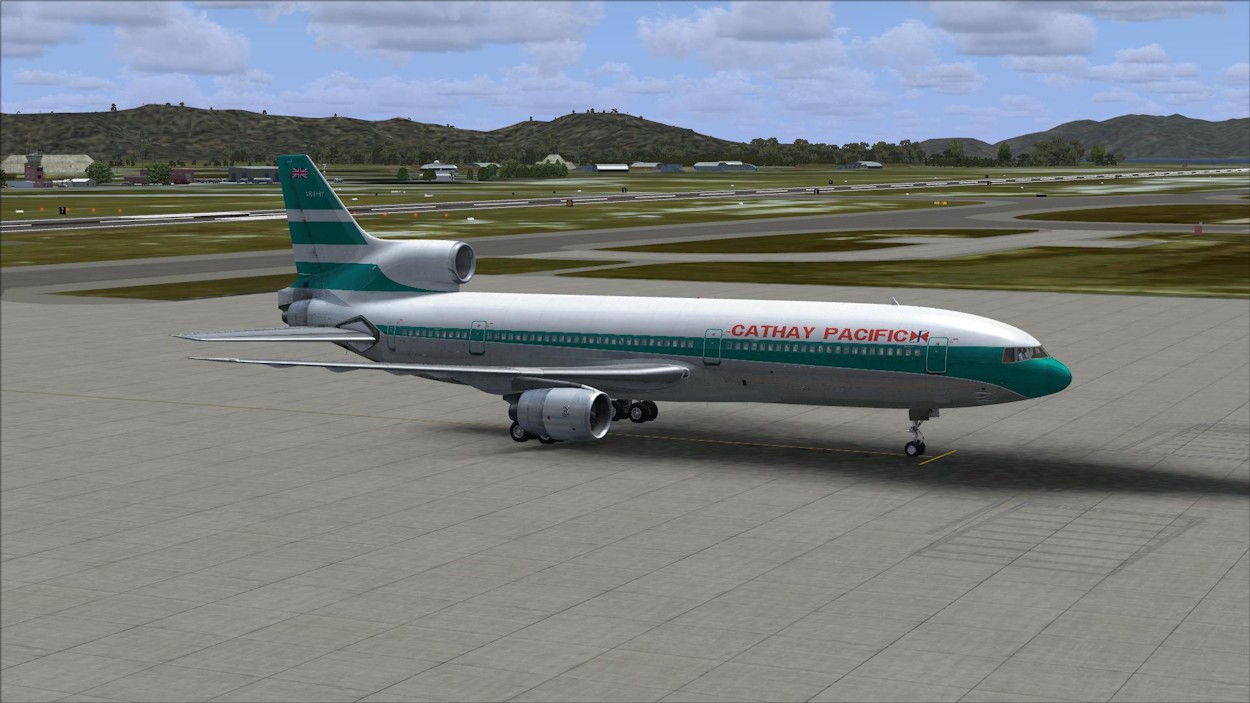 Cathay Pacific |
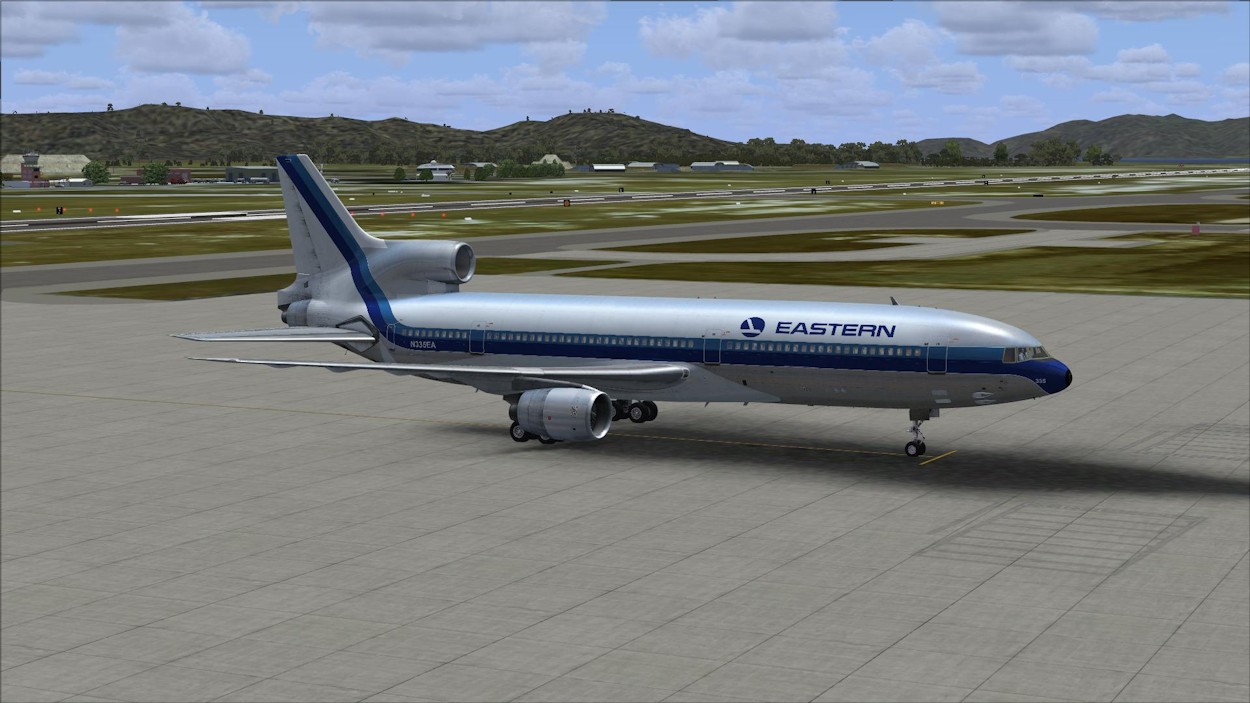 Eastern Air Lines |
As listed in the summary of major features, the animations on Captain Sim's '1011 Captain' and '1011-F' Freighter Expansion Model are extensive. These are modelled to the same high detail evident in other aspects of the product and all appear to be modelled faithfully. Of particular note is the 'dirty' black exhaust trail produced by each of the Rolls-Royce engines, a feature typical of the era. The animation control panel feature is also an excellent touch, especially for those who like to simulate to this level. This control panel provides control over all the static animation features and, on the '1011-F' Freighter Expansion Model, provides access to the main deck load manager control panel which enables you to simulate the loading of ULDs on the main deck.
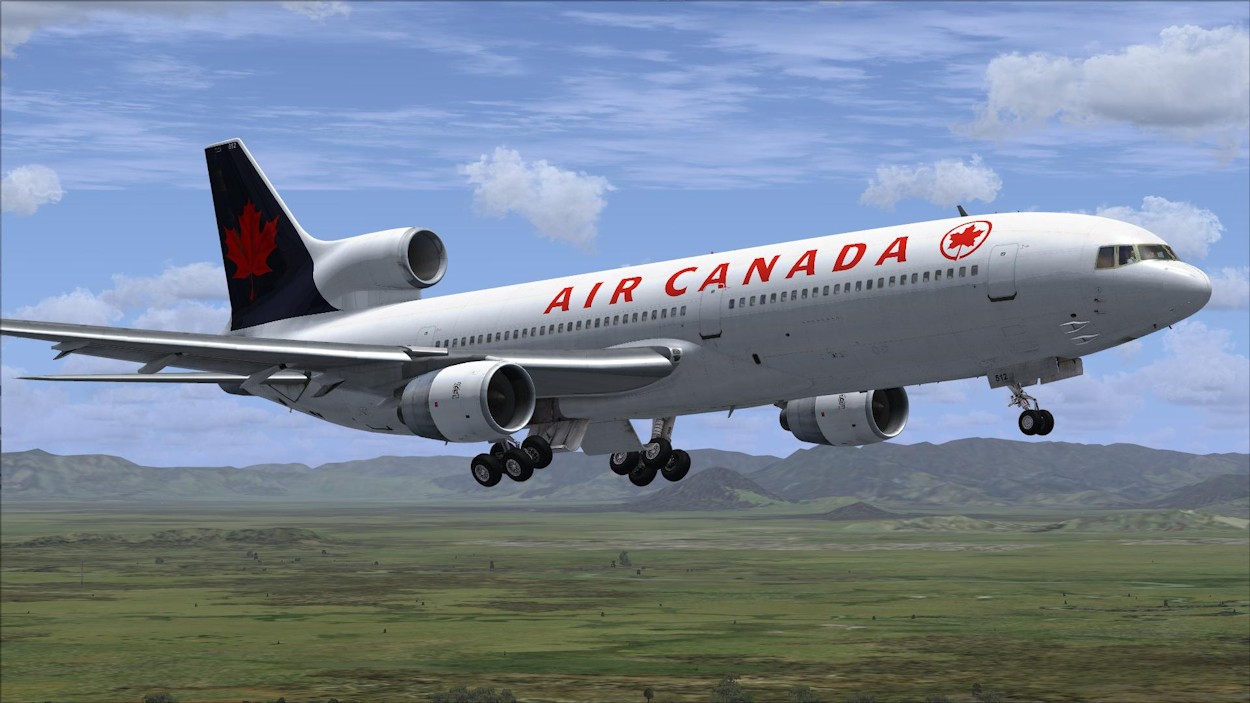 Gear Retracting |
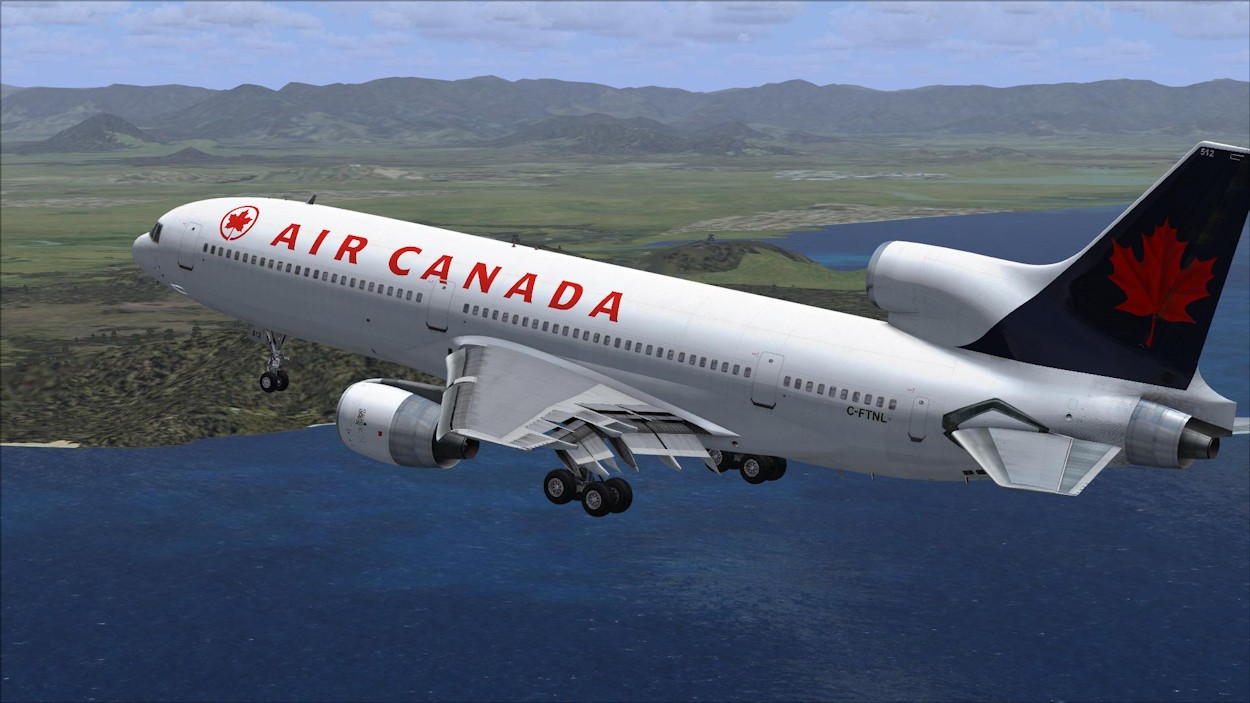 Configured for Landing |
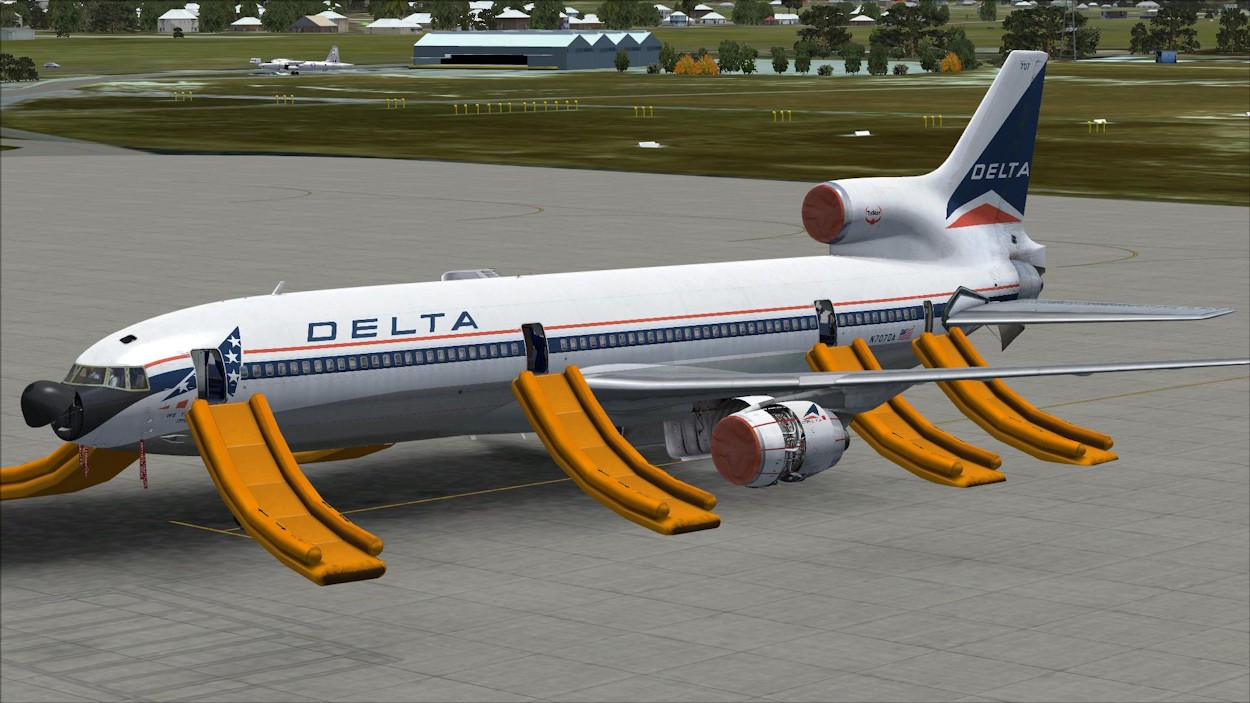 Static Animations - Port Side |
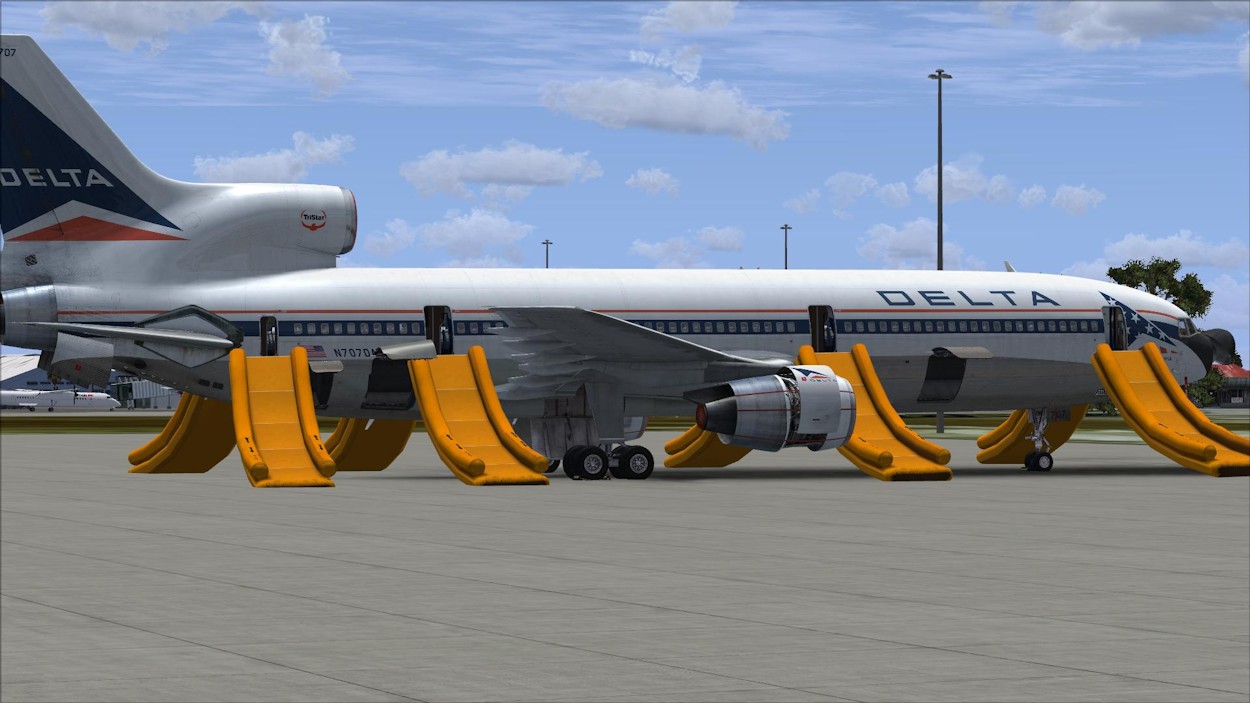 Static Animations - Starboard Side |
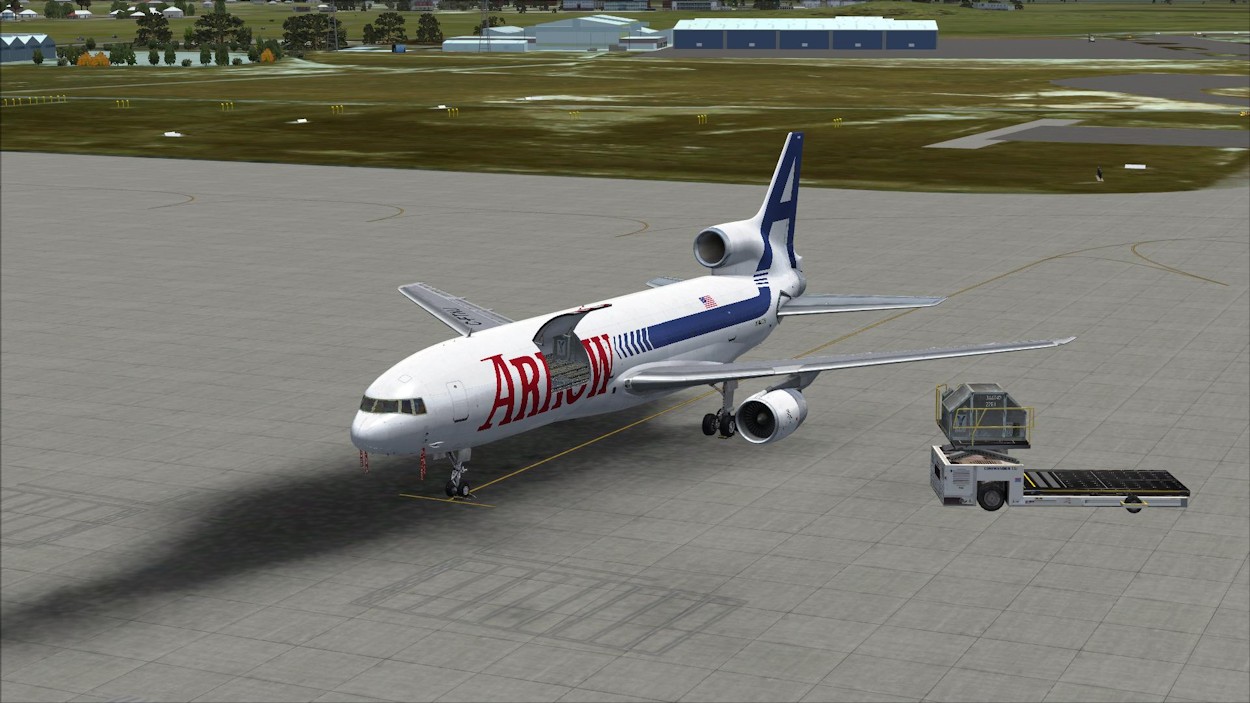 Freighter Main Deck Loader |
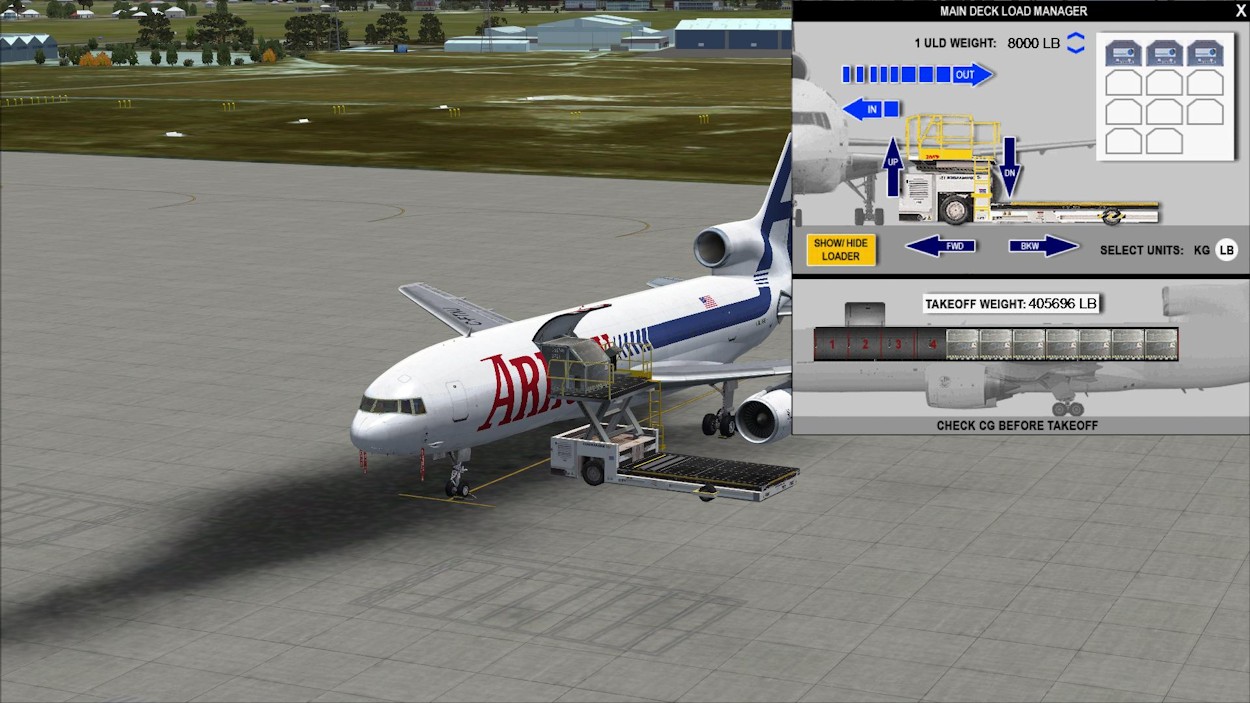 Main Deck Load Manager Control Panel |
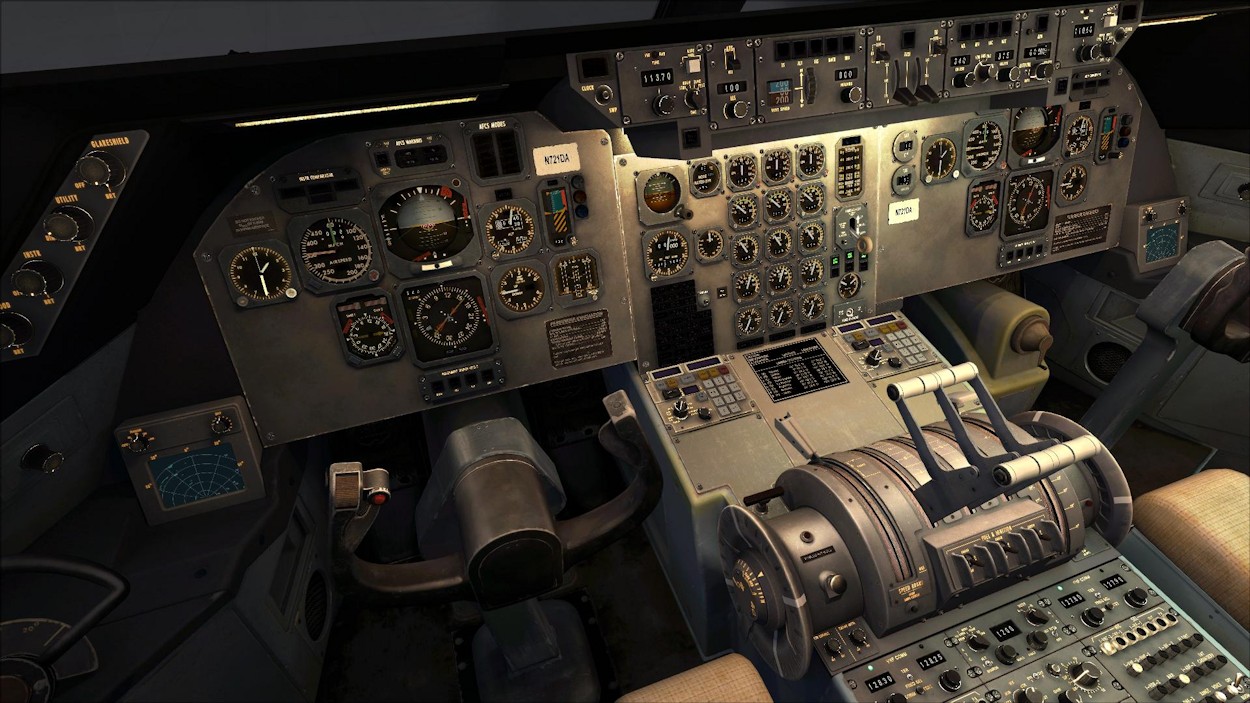 Panel Lighting |
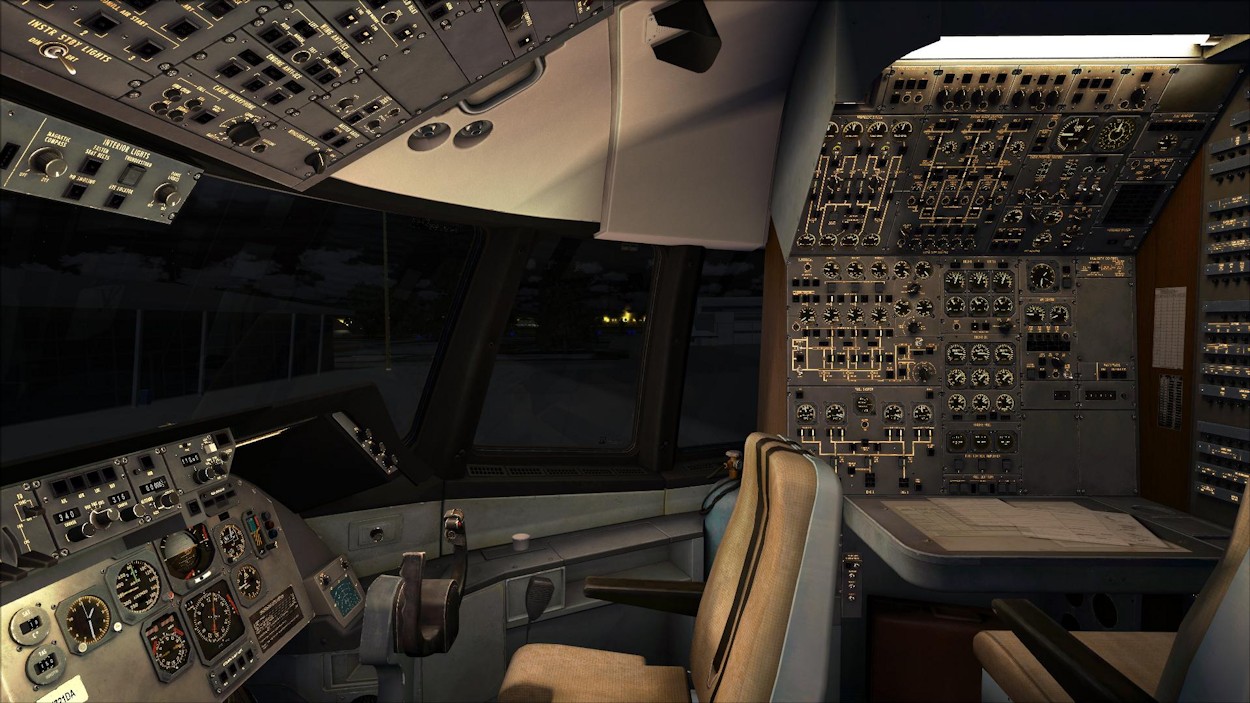 Cockpit Lighting |
General Characteristics and Performance Specifications
The general characteristics and performance specifications for the Lockheed L-1011-1 'TriStar' are provided in the table. This is based on data from the data provided by Captain Sim and general research sources. Some of this data varies between sources and also may be an approximation due to variances in data and the specific aircraft modelled by Captain Sim.
 |
It is easy to overlook the fact that the L-1011 'TriStar' is a lot of aircraft and it will catch the unsuspecting flight simmer unawares very quickly. Close attention to the flight envelope, particularly during the climb, is essential or this aircraft will punish you mercilessly.
A specific Test Flight was conducted from Avalon (YMAV) to Changi (WSSS) to test the flight performance of the '1011 Captain'. The flight was conducted in clear weather with a full fuel load and the aircraft at maximum take-off weight (MTOW). A cruise altitude of FL340 was adopted and the route distance was approximately 3,260 nm. The route was particularly chosen to provide a basis upon which to test the range characteristics of the '1011 Captain'.
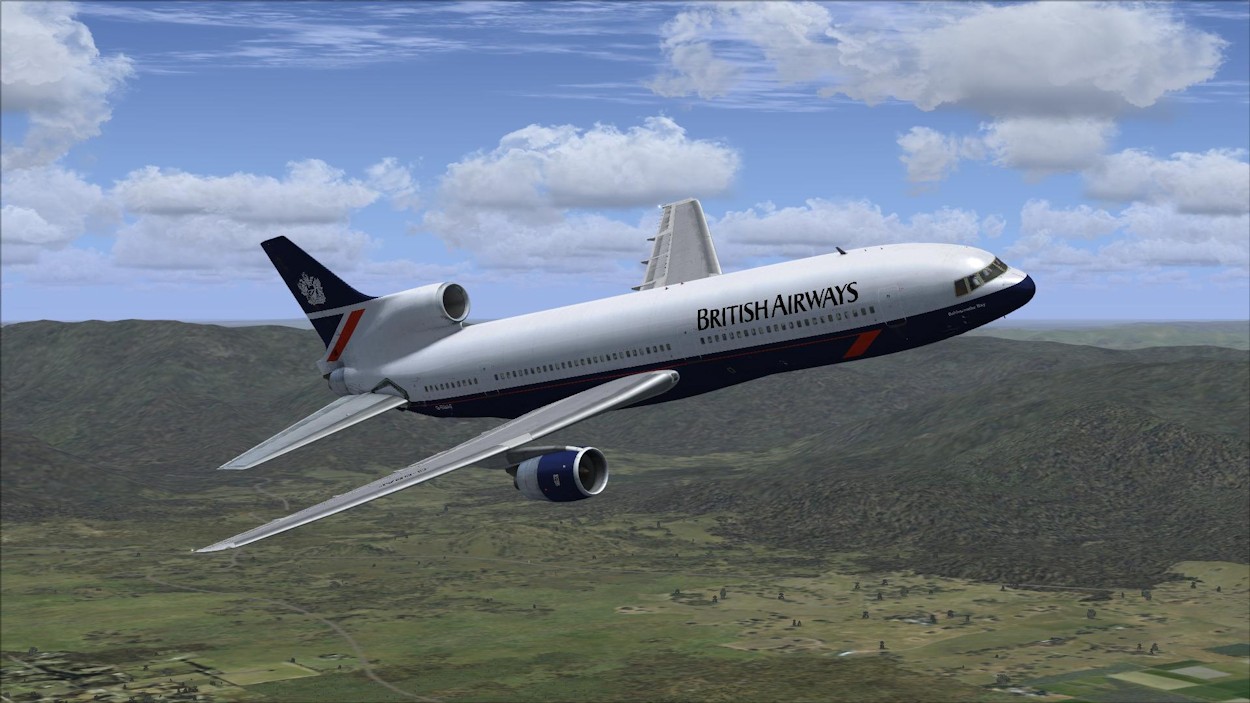 Climb Out |
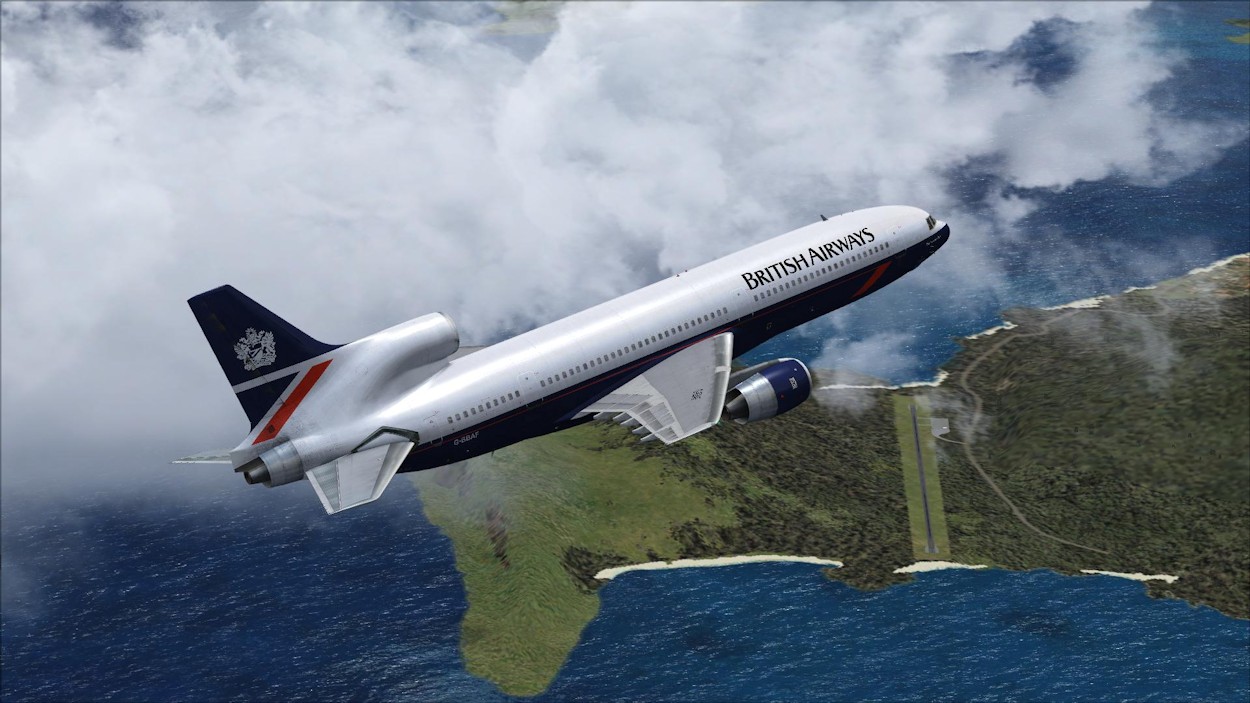 Through the Clouds |
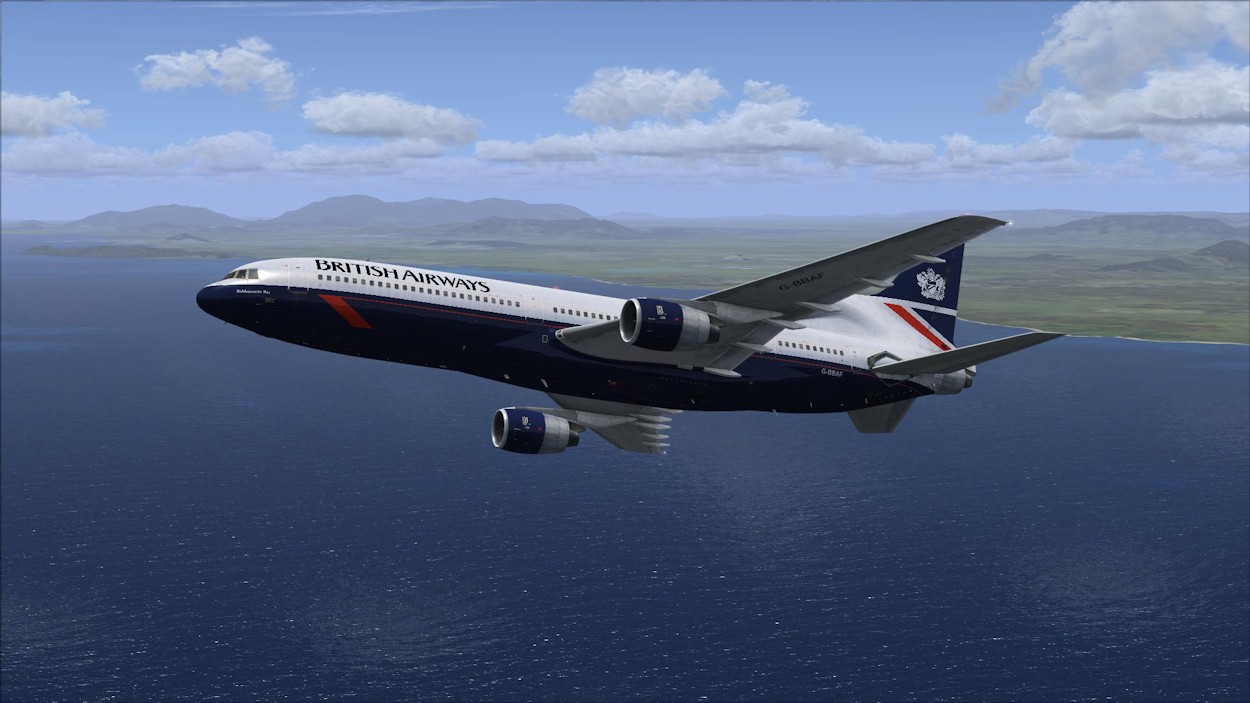 Course Change |
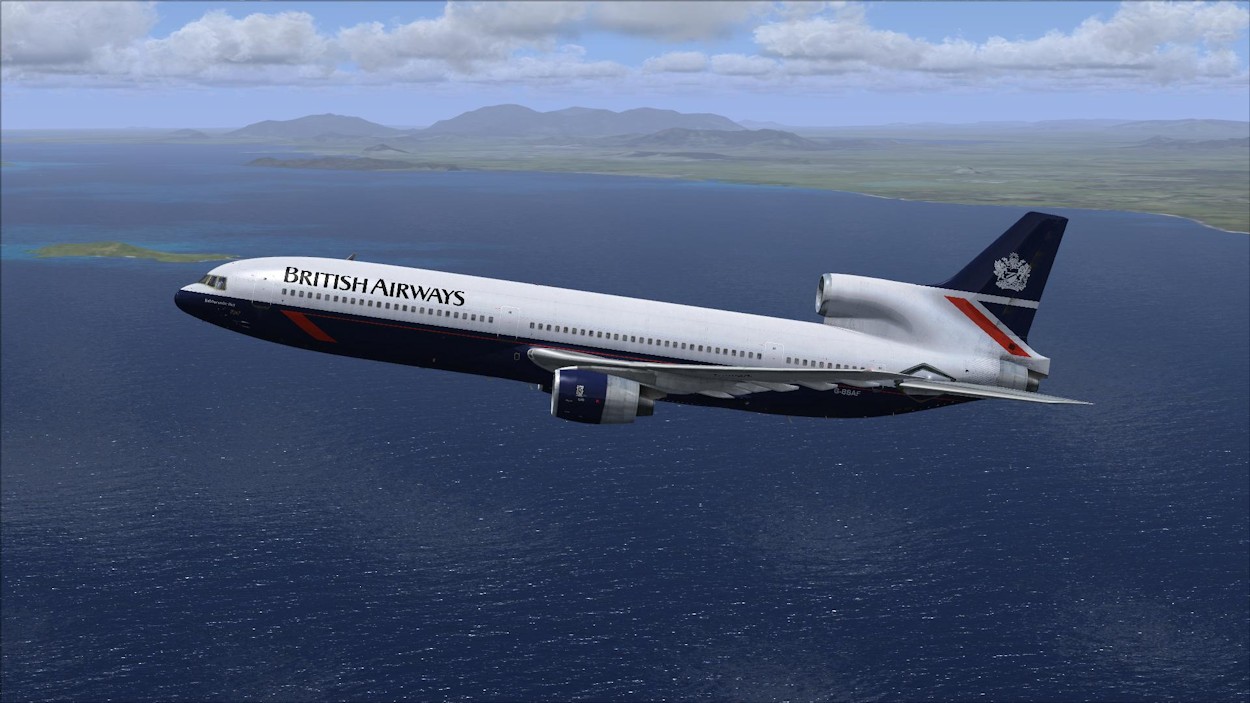 Pure Beauty |
In testing the accuracy of the instruments, based on the measured Test Flight, the speed indications on the airspeed indicator were consistent with the averages measured. Additionally, when establishing a set rate of climb on the vertical speed indicator, the respective gain in altitude on the altimeter was achieved within the measured minute, and a standard rate turn was achieved, consistent with the aircraft type.
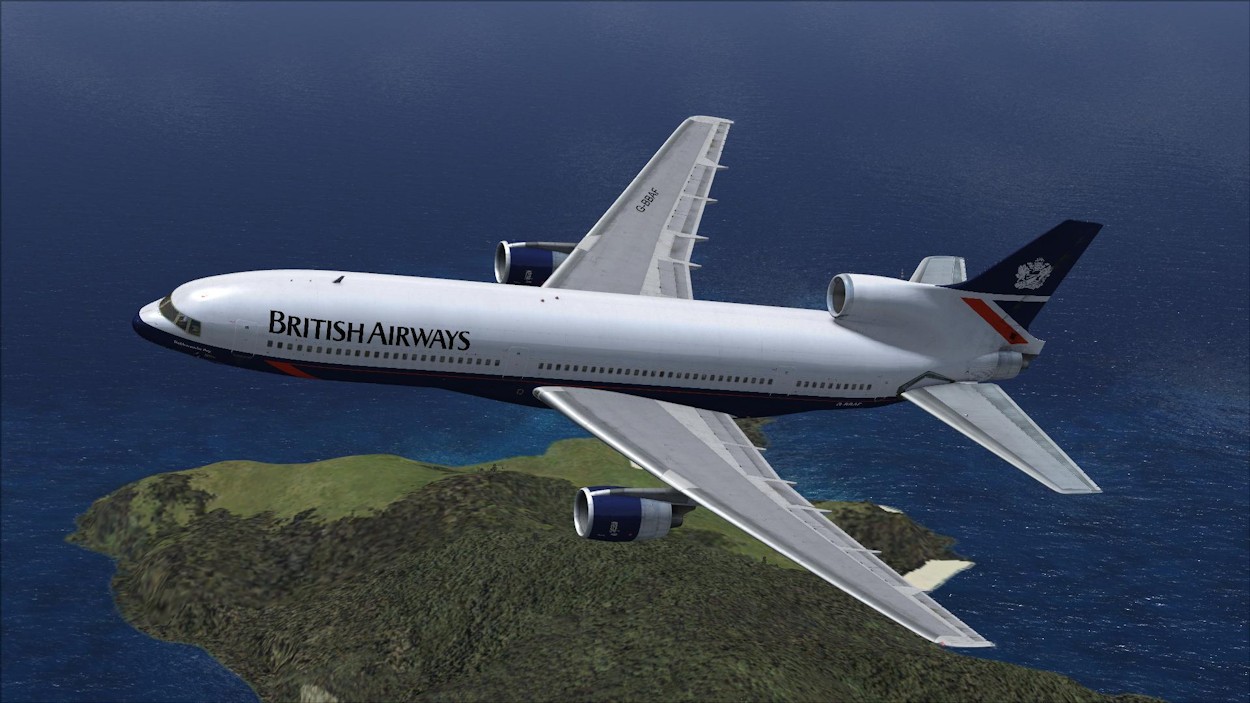 What a Picture |
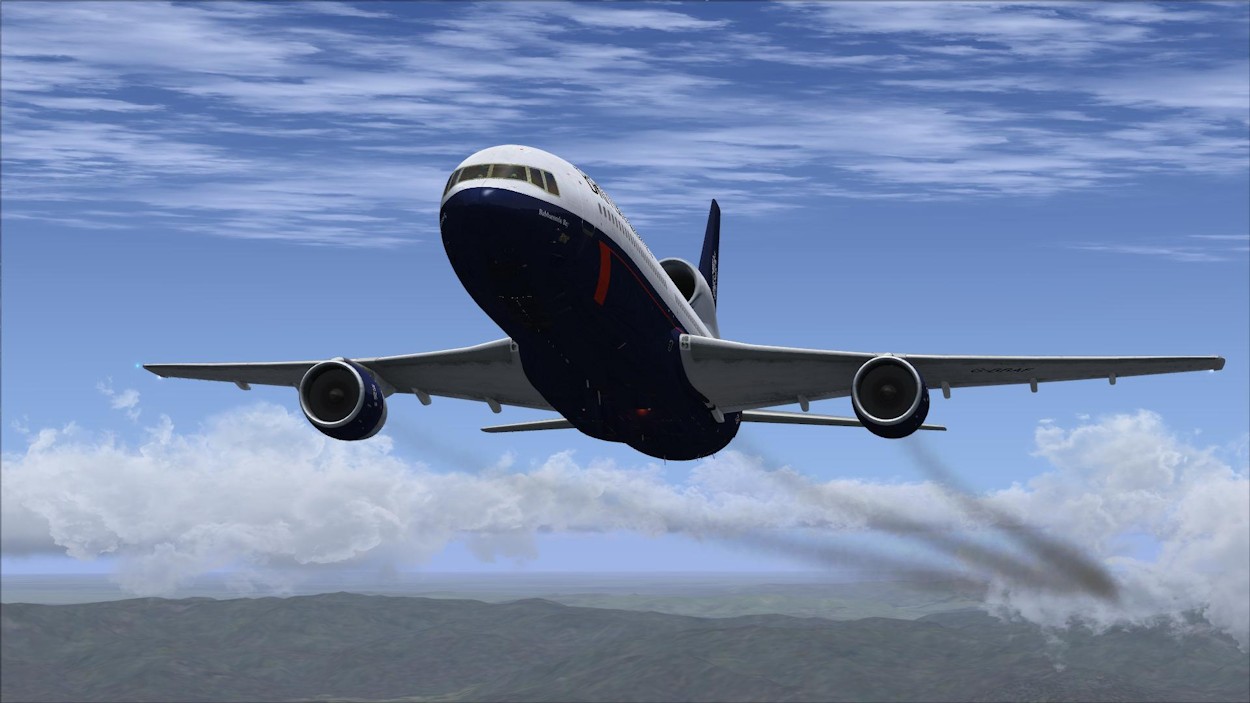 So Dirty |
Documentation
The '1011 Captain' has a flight manual, provided in three parts, available in Adobe Acrobat format (.pdf):
● Part I, User's Manual - this 26 page manual provides a description of the '1011 Captain' product;
● Part II, Aircraft and Systems - this 161 page manual provides a description of the aircraft and all the systems; and
● Part III, Normal Procedures - this 17 page manual provides a description, in pictorial form, of the various L-1011-1 flight patterns.
Each of these are available for separate download. There is an additional seven page document which provides an explanation of the Direct Lift Control (DLC) system on the Lockheed L-1011 'TriStar'.
Whilst the documentation is detailed, I was disappointed by the total lack of procedural checklists. It seems incongruous to model the aircraft systems to such a high degree of operating accuracy and then not provide the procedural checklists for the flight simmer to follow. This has been a strength of Captain Sim's product documentation in the past and this fact only adds to the level of disappointment. Admittedly though, there is a Captain Sim channel on YouTube which has an engine start guide video for the '1011 Captain'. A further lack of any performance tables for the aircraft is also disappointing, leaving the flight simmer to estimate these through trial and error. Overall, simply, this just does not 'cut it'.
Value for Money
For value for money, the '1011 Captain' and '1011-F' Freighter Expansion Model are considered exceptional. With the level of accuracy and detail in the modelling, it is a fantastic classic commercial airliner and a pleasure to fly.
Simulator Performance
The aircraft model performed exceptionally within the existing settings I have in FSX. I have most of my settings set very high and I also have the TEXTURE_MAX_LOAD entry in the FSX.cfg file set to 2048. There was no need to make any adjustments to these settings and FSX continued to perform smoothly, as it would with any default aircraft.
Technical Requirements
This version of the '1011 Captain' is for FSX only. The '1011-F' Freighter Expansion Model is for FSX and P3D. Other specified technical requirements are as follows:
● Windows XP SP2, Vista, or Windows 7;
● Microsoft Flight Simulator FSX with SP2 (or Acceleration Pack) installed; and
● Pentium V, 3GHz equivalent or higher, 1GB RAM, 512MB graphics card, and 1.5GB available HDD space.
Review Computer Specifications
The specifications of the computer on which the review was conducted are as follows:
● Intel i7 990X Extreme 3.46GHz;
● NVidia GTX580, 1536MB graphics;
● 12GB Kingston DDR3 2000MHz;
● Windows 7, (64bit);
● Microsoft Flight Simulator FSX Acceleration; and
● additional major add-ons include: Active Sky Next, REX Essential Plus Overdrive; Ultimate Traffic 2; Orbx FTX Global BASE;
Orbx FTX Global VECTOR; Orbx FTX Global openLC EU; Orbx FTX region series; and Orbx FTX airport series.
Conclusion
The '1011 Captain' and '1011-F' Freighter Expansion Models are great 'Pro Line' range offerings in the 'Nostalgy' series from Captain Sim. This review has involved over 20 hours of specific flight testing flying hours and it is evident Captain Sim have continued to live up to their reputation with the '1011 Captain'. Rich in detail and accuracy, it provides the flight simmer the experience of flying and managing a classic wide body jet of the 1970s. Whilst the lack of procedural checklists is disappointing, the '1011 Captain' and '1011-F' Freighter Expansion Model display an excellent balance of quality and detail at an exceptional price. If you are a fan of commercial airliners and, in particular, classic commercial airliners of the 1970s, you will thoroughly enjoy the Captain Sim '1011 Captain' and '1011-F' Freighter Expansion Model.
Verdict
The '1011 Captain' and '1011-F' Freighter Expansion Model are solid products which display a high quality and attention to detail and represent exceptional overall value for money.
Pros:
● Quality and attention to detail.
● Excellent external model.
● Detailed and fully modelled aircraft systems.
● Realistic flight modelling and performance.
● Good documentation.
● Exceptional value for money.
Cons:
● No detailed procedural checklists.
● No aircraft performance tables.
| Verdict: |
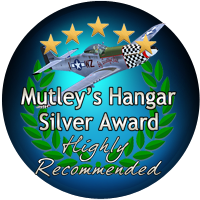 |
|
| • External Model: | 9.5/10 | |
| • Internal Model: | 10/10 | |
| • Sounds: | 8.5/10 | |
| • Flight Characteristics (does it fly by the numbers): | 9.5/10 | |
| • Flight Dynamics (does it feel like what it looks like): | 10/10 | |
| • Documentation: | 8.0/10 | |
| • Value for money: | 10/10 |
| The Captain Sim '1011 Captain' and '1011-F' Freighter Expansion Model are awarded an overall Mutley’s Hangar score of 9.4/10, with a "Highly Recommended" and a Mutley's Hangar Silver Award. |
.jpg)
